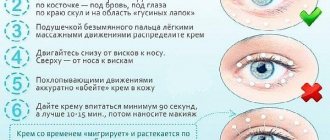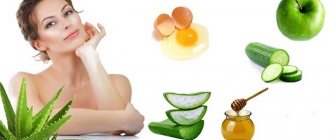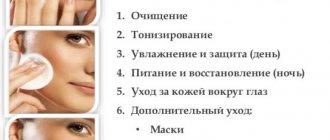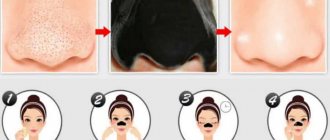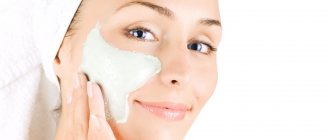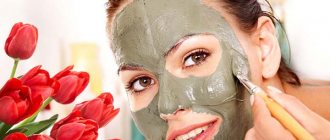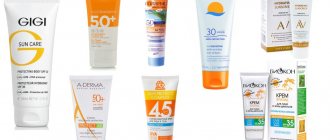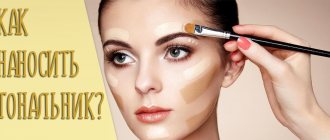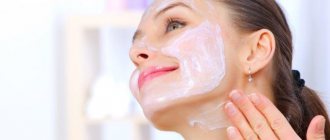Issues discussed in the material:
- How to perform facial care using masks
- How to prepare your skin for applying a mask
- Why you can’t keep the mask on your face for more than 30 minutes
- How can you apply face masks?
- What are the secrets of homemade face masks?
At all times, women strive to look attractive and maintain their beauty and youth. Representatives of the fair sex pay special attention to facial skin care so that it is radiant, smooth, velvety, and has an even color. And the most important goal is to maintain her fresh, youthful appearance for as long as possible. Those who have already reached the age of 25 need to more carefully monitor their skin condition. To do this, it is worth studying the secrets of face masks to achieve the maximum effect from their use, as well as the technology and methods of their preparation. This is exactly what this article will be about.
How to properly apply a mask to your face
The main secrets and rules of this procedure:
- The mask should be applied along the massage lines of the face: from the chin, from the upper lip and from the wings of the nose to the temples.
- Avoid getting the composition on the area around the eyes; it is better to moisturize it with cream in advance.
- Application tools must be absolutely clean and easy to use. Cotton pads, swabs, brushes, brushes, sponges, and hands are suitable for this.
- It is not recommended to keep the mask on the skin for more than 15–30 minutes; this time is enough to obtain an effective result.
- After you have applied the mixture, try to relax your facial muscles.
- Remove any remaining product with light massaging movements without stretching the skin.
- It is better to do masks 1-2 times a week for a month, then you can pause for 60 days, and after the break, resume the procedures again.
- Another secret: the composition that you are going to apply to your facial skin must be freshly prepared.
To achieve the best results, it is better to carry out procedures in courses lasting 2–3 months. Choose one recipe you like best and don't use any others. Never apply the composition to the area around the eyes and skin of the lips. If you carry out all the manipulations at home, make sure to remove the mask very carefully, this is a very important point.
Face masks are an excellent time-tested remedy; it’s not for nothing that cosmetologists actively use them. The secret of their effectiveness is that they perform a number of functions: cleanse the skin of dead cells, stimulate regeneration, soften and nourish the skin, open pores, and get rid of acne.
There are a huge number of recipes. Whatever ingredients are found in the composition - from exotic and rare (wheat germ oil or avocado) to the usual honey, egg yolk or oatmeal. Whatever the mask consists of, the result is the same: blood flow to the skin increases and the surface is cleansed.
The effect that is achieved immediately after applying the mask disappears quite quickly. It is impossible to turn back time and restore the skin to its former youth, because with age, less and less collagen is produced. But regular use will lead to a positive result: the skin will acquire a radiant, fresh and healthy appearance. The older you get, the more care you need to take, and it is especially important that it be regular.
Moisturizing cream
The first thing you should do is apply a suitable cleanser and moisturizer to your face. Dr. Dadu recommends using mild, gentle, fragrance-free cleansers to cleanse your skin. She said that after removing the mask, you should thoroughly cleanse your face with a cleanser and then apply a moisturizer according to your skin type.
"People with dry skin should choose cream-based moisturizers, normal skin types are best paired with a lotion-based moisturizer, and oily skin types are best paired with a gel-based moisturizer," she says. Buy a moisturizer with ceramides and hyaluronic acid, as they hydrate and make the skin elastic.
Pros of Homemade Face Mask Recipes
But do not underestimate the use of homemade masks, which consist of simple and affordable ingredients. Their undeniable advantages are their natural composition and freshness. After all, they do not contain (unlike professional formulations) preservatives or substances to maintain a uniform consistency. Their shelf life is quite short, which means they act on the skin as effectively as possible.
What to choose
Is it necessary to apply cream after the mask? Necessarily! But which one? This is where it is difficult to make a choice.
Before buying a suitable product, we recommend comparing them by composition online on a special website.
Even based on these tips, some cream may absolutely not suit one woman, while another may find it ideal. You shouldn’t base your decision on your friend’s advice; you are two different people with different skin textures. Study the compositions, experiment and only after that you will find exactly your face cream.
Secrets of face masks for different skin types
Once again about the rules that must be followed to prepare masks at home:
- first study the recipe for a homemade mask, prepare all the necessary ingredients and the container in which you will mix them;
- cleanse your facial skin;
- distribute the composition with smooth, light movements, do not press on the skin or rub;
- You need to prepare the mask immediately before use;
- rinse off 15–20 minutes after application.
1. Homemade masks for dry skin.
If your facial skin is prone to dryness, it means it lacks moisture and the sebaceous glands are not working well. Therefore, you should select recipes with a large number of moisturizing ingredients.
- Oil mask.
The secret of preparation is that cotton wool or a clean piece of cloth is soaked in vegetable oil heated to a warm state and applied to the face for 20 minutes. Remove any residue using a cotton pad soaked in hot water, then pat your face dry with a cool, damp towel.
- Curd and oil mask.
Another good recipe for dryness that nourishes and softens the skin. Combine 2 tbsp. l. cottage cheese and 2 tsp. vegetable oil, leave on your face for 10–15 minutes, remove any remaining product as in the previous case. To prevent the appearance of wrinkles, another composition is suitable: 2 tbsp. spoons of flour, yolk of 1 egg and 1 teaspoon of honey. First, mix the flour and yolk, then add honey, apply for 10-15 minutes, after this time has elapsed, remove the residue with warm water.
- Potato mask.
Boil one large potato in its skin, wait until it cools, then peel and mash it to a paste. Add 1 egg yolk and 0.2 cups of milk to it. Heat the resulting puree in a steam bath to 30–35 degrees and apply an even layer to your face for 15–20 minutes. Potatoes not only perfectly moisturize the skin, but also prevent moisture loss.
- Cucumber mask.
Take 1 medium cucumber and grate it on a medium grater, add a tablespoon of thick sour cream to it. Apply the resulting mixture to the face and neck for 20 minutes. Remove any remaining mask with cool water and wipe your skin with cool milk using a cotton swab.
2. Homemade masks for normal facial skin.
Clean (without inflammation and acne), smooth, smooth, moisturized facial skin (this is what is considered normal type) can be considered healthy. In order to keep it in good condition, it is enough to use vegetable and fruit masks in your home care.
What to do and how to care for your skin
Care largely depends on the skin type and the changes that appear. It is better to make an appointment with a dermatologist and choose individual care. However, there are a few simple rules that can be implemented right away.
Let's start from the very beginning, that is, with the mask itself. While any can have a negative effect on your skin, what it's made of matters. The better the quality of the fabric, the less impact on the skin and the fewer unpleasant problems.
Cotton or other natural, breathable material is the best choice.
Wash masks regularly. This is one of the basic rules that is extremely important for skin care. It is better to use several masks so that you can change them more often.
After each use, be sure to wash, dry and iron at high temperature. For washing, use mild detergents, without fragrances or dyes. Rinse thoroughly after washing.
It is also worth paying attention to the color of the mask. It is desirable that it be plain, ideally white. Fabric dyes can also cause irritation and allergies with prolonged contact.
In situations where the mask must be worn for several hours, clean the face with wet wipes. This additional measure will remove excess sebum and sweat. Prevents the growth of bacteria.
Use a protective cream that will create a barrier between the skin and the mask. Provides hydration that minimizes irritation.
Masks increase skin sensitivity. Therefore, it is better to abandon intensive cosmetics and aggressive care procedures. Preference should be given to soft ones that do not irritate the skin. In a word – minimalism.
For cleansing, use soft products with a neutral pH so as not to destroy the natural skin barrier.
For oily skin, a moisturizer is suitable. Sensitive and dry nourishing cream. Such funds may include:
- Vitamin A and E;
- Calendula or aloe extract;
- Lipids, for example, evening primrose oil, raspberry seed, almond.
Such ingredients have a calming effect.
If there are abrasions on the skin caused by the mask, it is better to use a moisturizing cream or ointment, for example, with vitamins A and E or zinc oxide, which has a healing effect.
For atopic skin or skin prone to irritation, it is better to use pharmaceutical dermocosmetics without fragrance, preservatives or dyes.
Make a face mask twice a week.
When is the best time to make face masks according to the phase of the moon?
When can you make masks for the face, hair and body according to the lunar calendar?
Masks according to the lunar calendar - a recipe for beauty for all times
Rule No. 1: on the waxing Moon, when it is in the constellations Leo and Sagittarius, the effectiveness of masks for hair, face and body is 100%. It is on these days that you can significantly improve the condition of your hair and restore youth to your face and body. On the growing Moon, they do what they want to “grow”, increase and multiply in themselves, be it masks for hair growth or for fresh skin.
Rule No. 2: on the waning Moon in the sign of Pisces, Aries, Scorpio and Cancer, no manipulations should be performed. On other days, devote time to what should decrease along with the heavenly body - at this time it is good to make masks against wrinkles, acne or freckles, as well as carry out procedures to get rid of unwanted hair on the body.
Lunar calendar for masks, the meaning of lunar days
From 1 to 5 days - New Moon. You can use all types of masks consisting of natural ingredients and prepared with your own hands.
From 5 to 8 days - waxing moon. It is recommended to care for hair that suffers from split ends and skin that has a lifeless, dull appearance. For the body and face, use any restorative masks that can restore youth and beauty.
Day 9 - take a break from cosmetic procedures, because this is not the best day for medical or caring activities.
Day 10 – it is recommended to start fighting dandruff, acne on the face or cellulite on the body.
Days 11-18 - during this period it is good to make medicinal masks that are aimed at combating seborrhea, acne on the face and body; the effectiveness of masks for the treatment of psoriasis and other skin diseases increases by 100%.
Days 19-21 - try not to overuse masks that serve to restore or increase skin elasticity; during this period it is better to limit yourself to regular baths or rinsing.
Day 22 – masks for the body and face will help get rid of deep wrinkles; it is recommended to use stronger cosmetic preparations that have a higher concentration of beneficial nutrients.
Day 23 is the day of beautiful hair and thick hair. This is not the right time for home remedies.
Days 24-26 are a rather difficult period of the waning moon. For the face and body, you can use not very aggressive formulations. Hair masks should be avoided.
Days 28-29 are a time of relaxation and complete rest. During this period, the skin absorbs and “digests” the set of vitamins and nutrients that were received earlier.
The cycle of using additional skin and hair care products is quite simple; the lunar calendar for masks will be an excellent assistant for you, capable of making any procedure as effective as possible.
Of course, each woman decides for herself whether to believe in such measures or be skeptical about them. But if you take into account the instructions of the lunar cycles, they can become an excellent assistant and companion in the pursuit of beauty.
But this information will be useful regardless of the chosen mask and moon phase:
The need to use moisturizing face masks
Early skin aging, the appearance of wrinkles, and dry skin can be caused by various factors.
This is a disease of the nervous system and if the functions of the endocrine glands are impaired, if you have unfavorable working and living conditions, a fundamentally impaired diet, and an important factor is the improper use of cosmetics and lack of moisture, both in the environment and in the cosmetics used. Applying nourishing and moisturizing creams to your skin is not enough to replenish the moisture lost from human skin. Moisturizing face masks can do this. Moisturizing face masks can easily cope with this cosmetic problem. Naturally, some diligence and punctuality are required in carrying out the relevant procedures. An interesting fact is that oily problem skin needs additional moisture much more than dry skin. How can this be? After all, the lipid layer of the skin, covering it with a greasy film, prevents moisture from evaporating from the surface of the skin. That's how it should be! But those with oily skin are often irritated by the oily, shiny sheen on the surface of the skin, and they try to get rid of it by all means and means, thereby overloading their skin. As a result, the skin becomes irritated, weakened and dried out. Oily skin tries to replenish moisture loss at its own expense, and this leads to even bigger problems. No one even thinks that it is enough to moisturize oily skin correctly and on time in order to rid it and yourself of painful imperfections.
Signs of moisture loss for all skin types
Signs of moisture loss are the same for absolutely all skin types. And this should serve as a signal to start using moisturizing face masks. So how can you tell when your skin needs some extra hydration? We answer, -
- if you see that the skin has lost its elasticity;
- skin tone has become dull and grayish;
- irritation, peeling, redness are observed on the skin;
- many wrinkles appeared;
- the skin feels tight.
Caring for dehydrated skin must be approached comprehensively. The most effective for combating dehydrated skin are the proposed face masks. And they must be done in order to maintain the already achieved result and to prevent moisture evaporation.
In order for the skin to remain young and healthy, firm and elastic for a long time, moisturizing masks should be done at least 2-3 times a week.
Masks at home
Many girls prefer homemade masks made from natural ingredients to purchased masks. Indeed, such masks will not contain unnecessary components that are harmful to the skin; they will be absolutely natural and inexpensive, since they are made from components already available in the kitchen.
What to make a mask from? Read more about recipes for homemade face masks in our article. The most popular components of homemade masks are gelatin, honey, oatmeal, cucumber, tomato, yolk, protein, fruit (lemon, banana, strawberry), clay, sour cream and cottage cheese. A honey mask moisturizes and nourishes the skin, a fruit mask saturates with vitamins and cleanses, a gelatin mask tightens the skin.
LiveInternetLiveInternet
Saturday, May 21, 2011 11:39 + to quote book
| Those who love themselves and know how to take care of themselves and their bodies know that face masks (both store-bought and homemade) can make the skin smooth, fresh and radiant. It is almost impossible to achieve such an effect with cream alone. However, even such a seemingly simple procedure as a face mask has many nuances and subtleties. And today the women's site owoman.ru offers you many secrets that will help you achieve the most effective results when using face masks. So, which face mask is better to choose: a homemade mask or a store-bought one? If you choose a homemade mask, what time of day is best to make it? How to apply a face mask, and what is the best way to wash it off? And what can you do with a face mask if it doesn't suit you? Do we need a face mask, or is cream enough? Many modern women do not consider it necessary to use face masks, believing that applying cream will help keep their facial skin at its proper level for a long time. However, this approach is fundamentally wrong. Moreover, there are certain skin care programs that involve the use of only face masks, proper cleansing of the skin and moisturizing the skin with thermal water. There is no need to use cream. Face masks are one of the most powerful and effective anti-aging remedies. It is not without reason that beauty salons offer masks for the skin as firming, moisturizing, and rejuvenating products. The thing is that a face mask contains much more active substances, it is better absorbed, and, in addition, it brings a more noticeable effect than that brought by the daily use of creams. While you are young, you can easily do without a face mask, but after thirty, a mask should be a mandatory ritual for you, which must be performed 2-3 times a week. Which face mask should you choose? There are two types of face masks - masks that we prepare ourselves (homemade face masks) and purchased masks. Of course, we are talking about those masks that do not require the services of beauty salons, that is, those that we can apply ourselves. So, purchased masks are masks that we, accordingly, buy, and then take out from tubes, boxes, jars and apply to the face. We make homemade masks ourselves - we mix them from various ingredients. Which mask to choose, you ask. In order to answer this question, we will tell you in more detail about each of these types of paints. Most often, the choice is determined by the availability of free time. That is, if you are short on time, the choice is obvious - let’s go buy a face mask in the store. However, if you are short on time, you should remember that you should not use a mask that you have never tried before. The effect may not meet your expectations (and this is to put it mildly). If time allows, you should calmly evaluate all the advantages and disadvantages of purchased masks. Usually, expensive store-bought masks contain many very effective components that simply cannot be present in homemade masks. Especially if you purchased a professional face mask. But in addition to their advantages, purchased masks also have disadvantages: The mask you purchased in a store (or pharmacy) may simply not suit you. You may experience skin reactions such as allergies, irritation, dryness or excessive oiliness of the skin. Or it may have no effect at all - just wasted money. In addition, any purchased mask contains preservatives that end up on your skin along with beneficial components. That is, along with useful substances, we “feed the skin” with preservatives. And this, accordingly, is harmful to the body. In addition to all of the above, store-bought face masks are more likely to cause irritation or allergies than homemade masks. This happens due to the presence of highly effective components and the same preservatives. And due to the fact that each mask contains a fairly large number of ingredients, you may simply not understand what exactly caused the negative reaction. Also, the composition of purchased masks is unchanged; moreover, adding any component to such a mask can be harmful and cause the opposite of the expected effect. There is a possibility that your skin will get used to the mask, at least if you use an effective mask often enough - for example, every day. Homemade masks are not addictive. Homemade face masks Advantages of homemade masks: Firstly, you do not need to spend money (often quite a lot) in order to purchase a mask. You can simply use the products at hand - there is a huge scope for creativity - right? Especially considering the fact that a homemade mask can be made from almost any product. You can mix a mask not only from food, essential oils, clay, but even from spices! Secondly, homemade masks do not contain any preservatives, which means there is no threat to your skin - because you know what exactly you are putting in the mask you are preparing. Thirdly, through experiments you can get to know your skin better - what suits it, or what products you are allergic to. Well, and lastly, every day you can prepare completely different masks, alternate them - there is room for your imagination. Disadvantages of homemade face masks: No matter how simple a mask you plan to prepare, you will still have to spend time on it. Well, besides, like any other product, the mask or one of its components can cause you an allergic reaction. How and when to apply a face mask Not every mask can be useful - it all depends on whether it is made according to all the rules. Consider your skin's biorhythms Even if a face mask is ideal for your skin, even if you have been using it for a while and know that it is beneficial, sometimes such a mask may not have any effect - including if you apply it at the wrong time. Therefore, our site offers you the most optimal mode for applying face masks. So: 8.00-10.00 These two hours are the most optimal time when your skin is ready for any cosmetic procedures and will accept them with pleasure, and you will enjoy the excellent results of these very procedures. 11.00-12.00 This time is most suitable for applying masks that remove excess oil from the skin. 13.00-14.00 The most suitable time for relaxation. During this period, it is better to make a moisturizing mask and go to rest. However, one cannot expect any special results from a mask applied at this time. 15.00-18.00 It is better to devote this period to some other activities than face masks. At this time, your skin simply will not accept any nutrients. 18.00-23.00 The best period for cleansing the skin. You can use not only scrubs at this time, but also cleansing masks. However, any other masks will also be quite effective. 23.00-5.00 If it is during this period that you decide to take care of yourself, you should take a closer look at nourishing masks - at this time they are most effective. Cleanse your skin thoroughly with a scrub. Anyone knows that masks are applied to the face only after it has been completely cleansed! Therefore, before applying the mask, you should cleanse your face with your usual product, and then with a scrub. If you have time and there are no contraindications, you can deep clean your face using a steam bath. How exactly? Very simple. Boil water in a saucepan, to which it is advisable to add some herbs (chamomile or thyme). While the infusion is boiling, you need to wash your face. Then you should turn off the gas and bend over the pan with a large towel over your head. Keep your face over the saucepan for about 5-10 minutes. After this, feel free to clean your face with a scrub and apply a face mask. The effect will exceed all your expectations! Apply the mask to your face correctly. Do not apply the face mask to the area around the eyes, otherwise when it dries, it can cause wrinkles to appear on the thin skin around the eyes. It is better to apply some nourishing cream near the eyes and, accordingly, a mask on the face. You can apply the mask to your face using your fingers and a special brush (usually included with purchased masks). But it should be borne in mind that no matter what the mask is applied to the face, you should not stretch the skin. Many people are interested in the question of what layer to apply the mask - thin or thick. If you purchased a mask in a store, carefully read the instructions and recommendations and follow them. If the mask is homemade, it’s up to you to decide. But the larger the layer, the longer the face mask dries, and therefore works. While the mask is on your face, it is better not to strain your face. No need to talk, eat, etc. Just relax and lie down to rest. After all, grimaces during the procedure can cause wrinkles to appear. Do you need it? How and when to wash off the mask Usually masks are washed off after 15-20 minutes. Remember, your skin only receives nutrients while the face mask dries. If the mask dries out, it’s not a big deal, but you shouldn’t allow the mask to crack—this can again lead to the formation of wrinkles. If there are no other instructions on the package, wash off the mask with water at room temperature - in this case, the pores will narrow. Many women wash off face masks with their hands, but with a sponge you can wash off the mask faster without getting anything dirty. To begin, gently moisten the mask with a sponge, and then simply remove it, being careful not to stretch the skin of your face. Should I apply cream after a face mask? Many of us are so accustomed to constantly “treating” our face with something that when we go to bed without cream, we feel some discomfort. However, you should still let your skin breathe and be perfectly clean - believe me, it won’t get any worse. If your skin feels tight after a mask, this is one of the first “bells” that such a mask is not suitable for you. Take a closer look at this mask. However, if we talk about the cream, then applying it after the mask is welcome. What to do with a face mask that doesn't suit you? If you are using a face mask for the first time, listen carefully to how you feel. If you observe an effect such as tingling, this mask should be washed off immediately. At least if you don't want to walk around with acne. If a face mask causes you allergies or irritation, you should no longer use this mask. You can give a purchased face mask to your mother, sister, or friend - there is a chance that it will suit them. If the mask doesn’t suit you or your friend, it will make a wonderful mask for your feet and hands. Wash your limbs thoroughly, clean them with a scrub, then apply a thick layer of mask. It is better to wear cotton gloves and socks on top (on your hands and feet, respectively). And sleep. You won’t recognize yourself in the morning! |
[/td]
Y.S.
Tags:
face masks: secrets and tips
Cited 7 times
Like share
0
Like
- I liked the post
- Quoted
- 0
Saved
- Add to quote book
- 0
Save to links
Liked
0
Where are masks used?
In addition to medical institutions, these products are used in food production plants, in the kitchens of cafes and restaurants, in veterinary clinics, in educational institutions, as well as in research laboratories. The need to use masks in the above-mentioned institutions is due to the fact that they provide bacterial protection for patients and the processed material from infection during various manipulations. Masks should also be used if you are a carrier of the infection.
